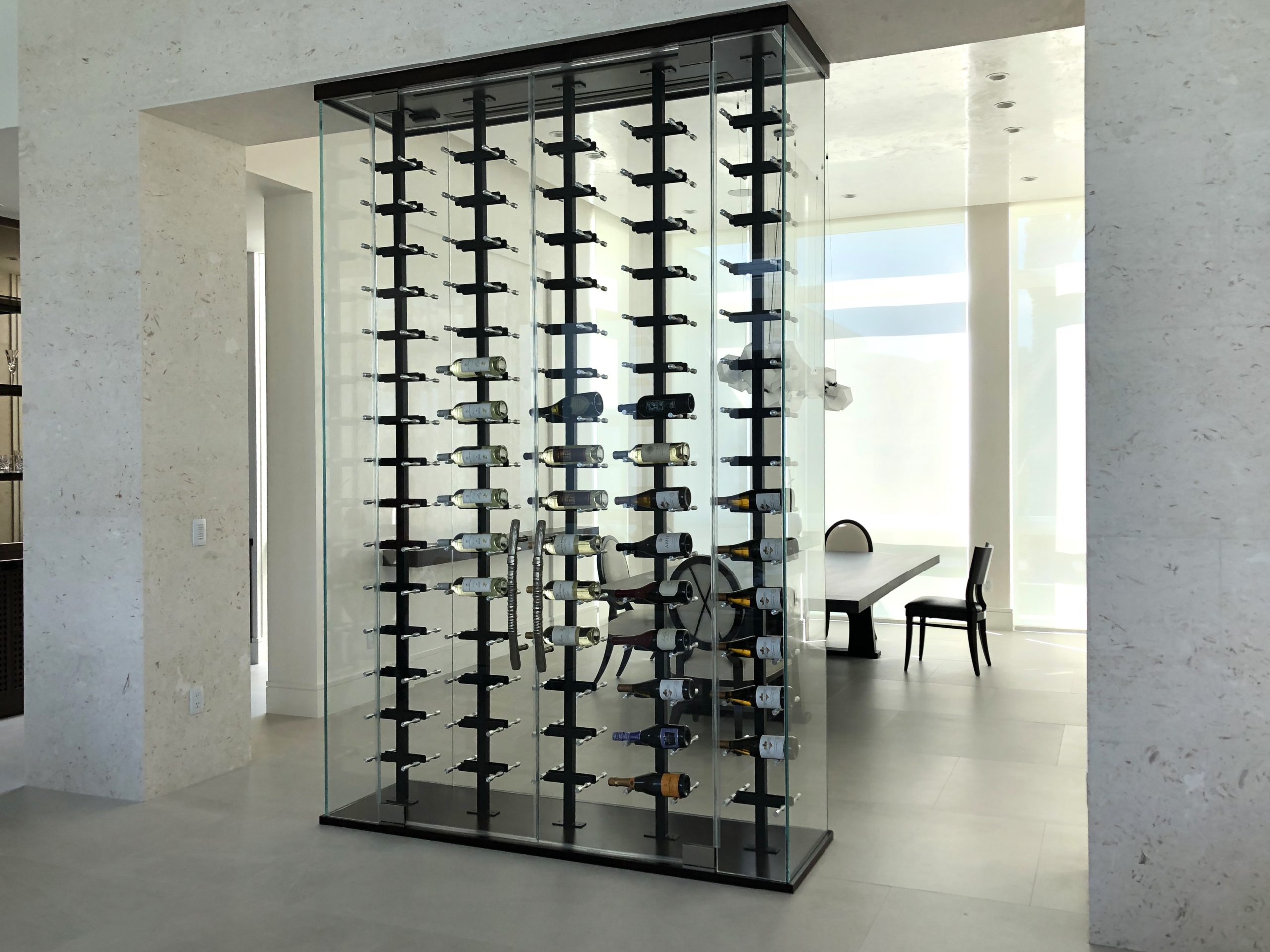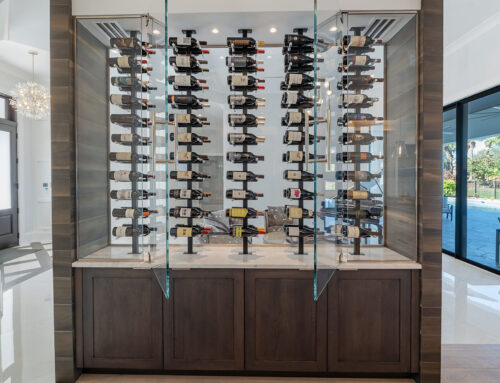I know there are at least a few people that actually read our blogs because they have called with questions after reading our wine cellar blogs. That’s right, I see you!! Building or constructing a glass enclosed wine enclosure is a lot more involved than having mirrors or even a shower enclosure installed. So I thought it might be helpful if we go over, from start to finish, everything to consider when building a glass wine cellar.
Location: Where can I Put a Wine Feature?
So, you’ve decided you want a wine feature in your home – great! But do you have available space? You probably do and you don’t even realize it.
Glass wine cellars do not need to be huge, monolithic type, wine enclosures. It is not a requirement that they absolutely dominate the space in an area. As impressive as these massive wine features are – we don’t all have that kind of space.
When considering a location of where to put your wine feature, consider static space that you are not utilizing. Can you possibly put a wine enclosure under the stairs? How about in a niche? Is there a closet that you just simply aren’t using?
Often times when we look at a room and think, “where,” we are only looking at active space. When we bring static space in as a choice, you now optimize your options so that you can create a more cohesive plan.
The other question to tackle here is, “how many bottles do I plan on storing?” Perhaps this is technically the first question we should ask, but let’s be honest here – it’s not. That and your available space will often dictate how much wine you CAN store.
Figuring out the bottle count that you would like to collect will help you in the long run on not just plotting out your space, but also figuring out what kind of racking system will serve you best.
I wrote a whole blog about wine cellar locations, that you can read here.
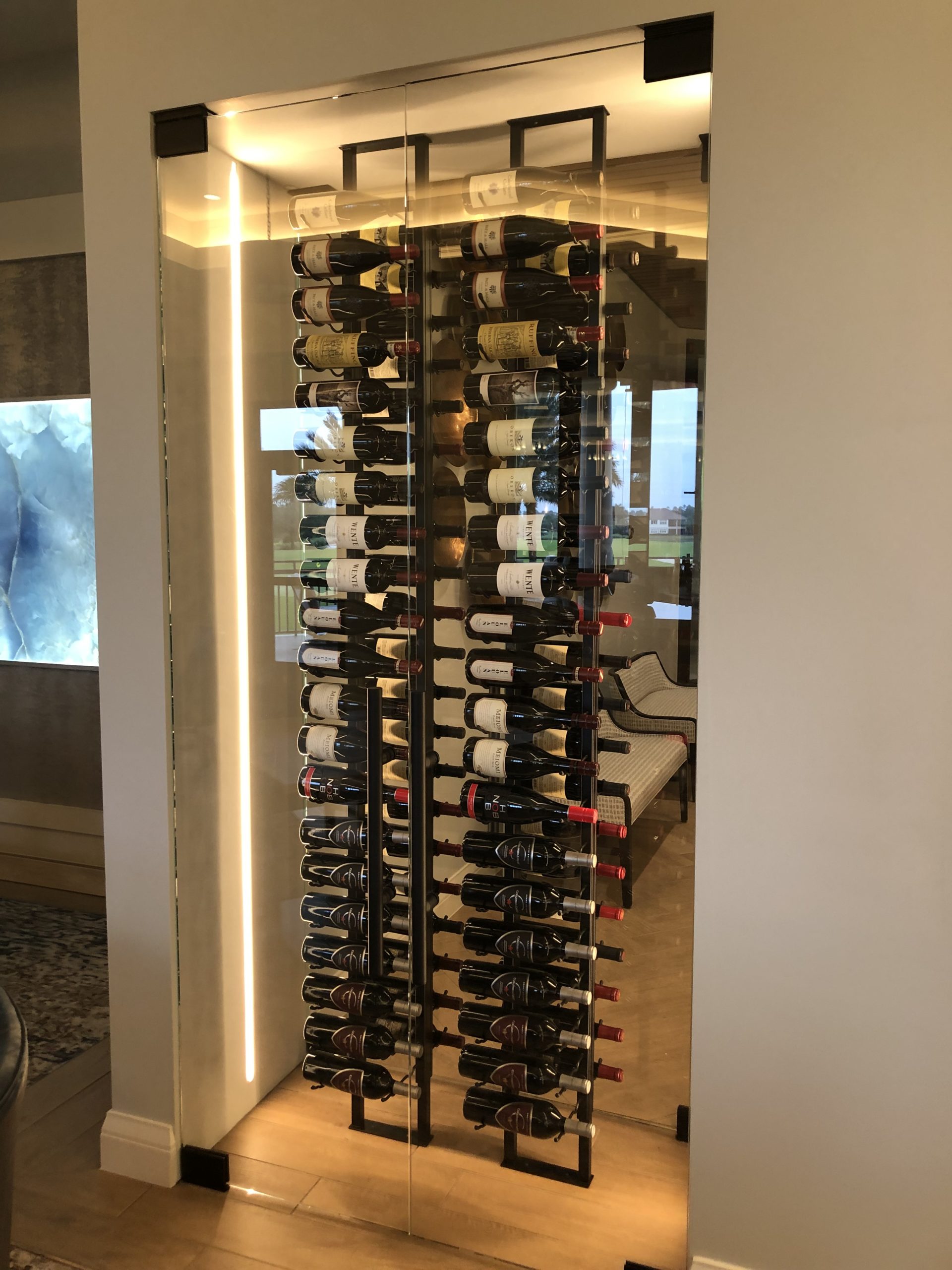
To Enclose or Not to Enclose, that is the Question
Is it true that you need to enclose your wine collection in glass? No, not really.
The style of your wine enclosure will be steered by two factors. What kind of space you are working with, and how long you plan on storing your wine?
Do you have space for glass doors that swing or slide? How much depth will you be able to have and will you be able to reach in and get what you need? Is the depth of your enclosure going to hinder movement in the space?
What we see most often, and tend to install, are glass enclosed wine features. But based on what needs you require your wine feature to serve, there are quite a few options to consider.
One of our favourite wine projects was a very simple, non-enclosed wine wall. With chrome, single bottle wall racking from Vintage View, and the use of Ultra Clear mirror, we were able to create the illusion of floating bottles in an open niche area. The feature is not enclosed in glass and creates a stunning place to both display and enjoy the client’s favorite wine!
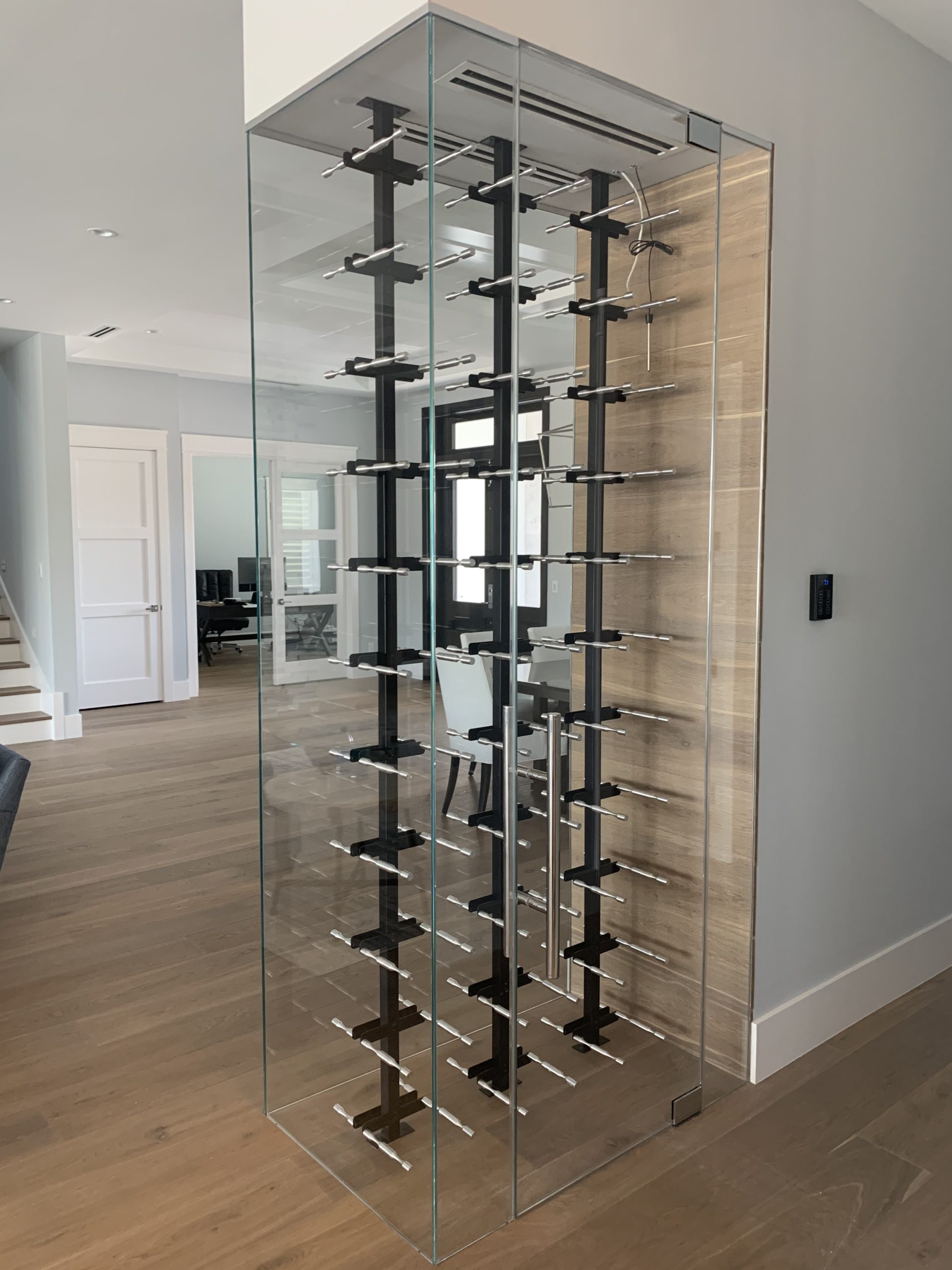

Insulated vs Non Insulated Glass
“But I want to have a refrigerated wine enclosure, so it needs to be insulated glass, right?” Again, that’s also a no. In fact, we don’t use insulated glass here for our installs.
Instead of browsing the internet looking for information, I decided to consult with our lead installer and pick his brain about the difference. Sometimes it really pays off to have an expert on hand!
Truthfully, when it comes down to it, both insulated and non insulated glass work in the same way – what it really comes down to is aesthetics.
Insulated glass is what automatically comes to mind people are thinking about refrigeration. The catch is- Insulated Glass Wine Units come with some pretty hefty framing. Insulated glass wine enclosures and cellars will have either wood or metal framing around the glass. Believe me, insulated glass is not an edge you want exposed, it’s not pretty. Most clients that are looking to use insulated glass are only putting glass in a wine cellar door, or in fixed openings that are framed out in wood. Insulated Glass Wine Rooms are typically done in aluminum storefront material. This is what you see in retail shopping centers- it is intended for exterior commercial use. It’s probably not what you are envisioning when you think of a Glass Wine Room.
½” tempered glass is what we have found to be ideal for our installs here in South West Florida. It allows us to create our beautiful frameless, jewel box like, wine features while also being functional and stable for refrigerated wine enclosures. Here in South Florida, it is hot, it’s humid, and we have had no issues with condensation using ½” tempered glass.
*Note: When you have your cooling systems installed, be mindful of where the vents point! Cold air directed at the glass is sure to cause condensation.
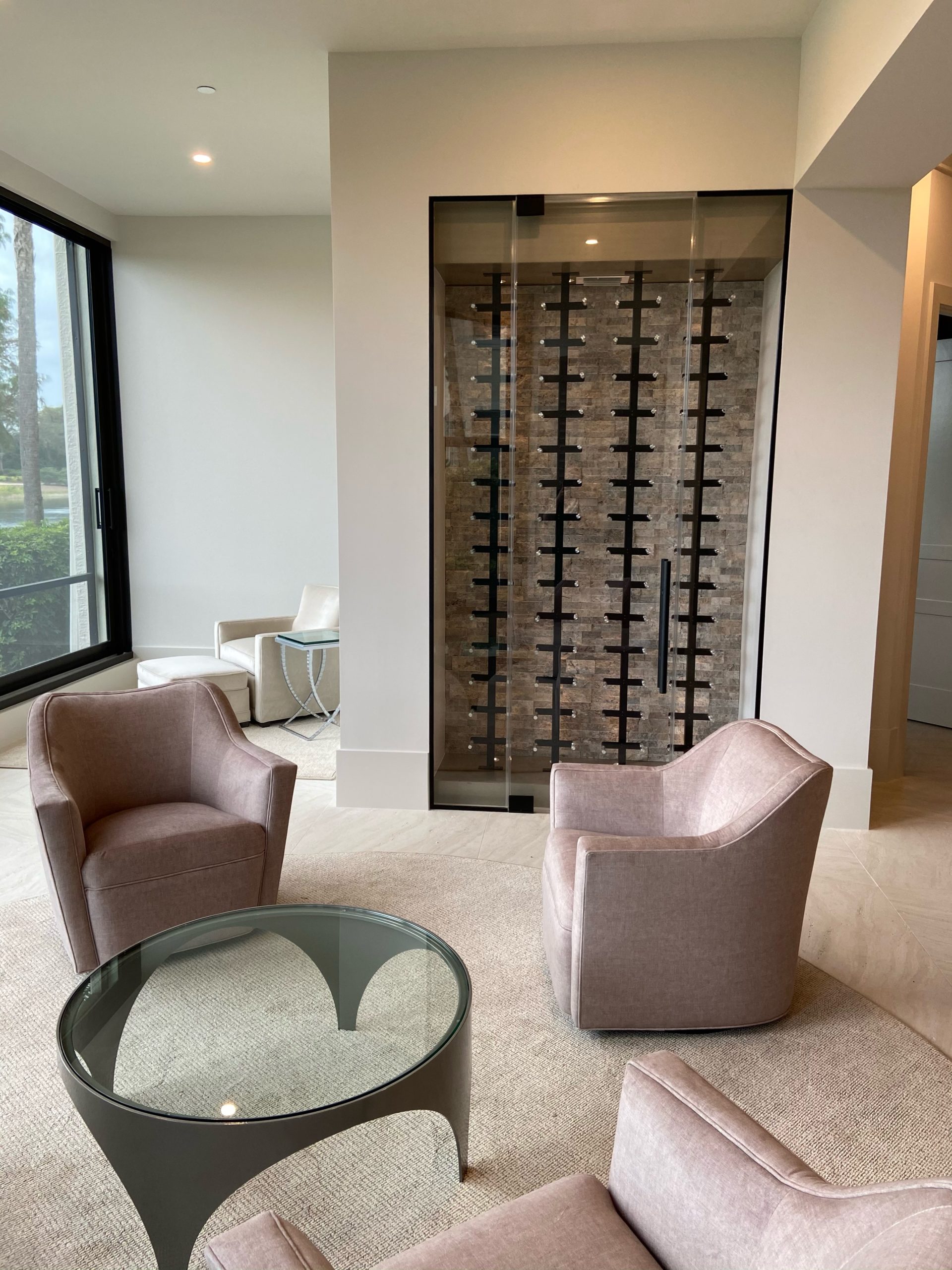
Climate Control vs. Non Climate Control
In the beginning, the majority of our wine enclosures that we were installing were for climate controlled cellars. Now it’s about 50/50.
For those collecting mass quantities of wine, refrigerated glass wine enclosures double as great storage space while also creating an impressive visual feature. But for those of us who are looking to store our wine short term – non refrigerated enclosures are great additions!
Most of our clientele are seasonal, and are not storing the major bulk of their wine collections here. But a huge, huge, factor that plays into deciding whether to refrigerate your new wine enclosure or not comes down to cost.
Before ANYTHING, make sure you have your cost points laid out.
A refrigerated wine enclosure is a lot more than just adding a cooling unit to a glass box. You will need to hire a contractor to have the walls of your wine enclosure outfitted and insulated, to handle being in a long term cooled ‘wet’ environment, as well as having the refrigeration installed. This area will be treated as a wet area. That means all your drywall will need to be replaced. Closed cell foam insulation is strongly recommended. We have heard of mold issues where closed cell foam insulation was not used. Not a risk we would consider taking.
Outside of the glass and racking costs, if you want to do it right, you can expect to add approximately $30k to your project cost for a climate controlled space.
Closing
When it comes to creating a glass enclosed wine cellar, there are a lot of factors to consider. Make sure that you have all of your plans and quotes laid out first before you jump into a project like this and, if you need some help, come stop in by our showroom! We may be able to help you get inspired.

